Common menu bar links
Breadcrumb Trail
ARCHIVED - Status of Women Canada
 This page has been archived.
This page has been archived.
Archived Content
Information identified as archived on the Web is for reference, research or recordkeeping purposes. It has not been altered or updated after the date of archiving. Web pages that are archived on the Web are not subject to the Government of Canada Web Standards. As per the Communications Policy of the Government of Canada, you can request alternate formats on the "Contact Us" page.
Section II – Analysis of Program Activities by Strategic Outcome
SWC’s Program Activity Architecture (PAA) for 2007–2008 identifies, as a strategic outcome, “gender equality and the full participation of women in the economic, social, cultural and political life of Canada.” This outcome is measured by the progress made in advancing the representation of and participation by women in the economic, social, cultural, and political aspects of Canadian life. SWC contributes to this outcome through its two program activities and the associated expected results.
Program Activity 1: Promote Equitable Public Policy
Financial resources 2007–2008 ($ millions)

Human resources 2007–2008 (FTEs)

Program Activity 1 is designed to facilitate SWC’s horizontal role across the federal government by providing expert advice, delivering training, and developing tools in order to build capacity for gender-based analysis (GBA) among departments and agencies. GBA is the process by which social and economic differences between the sexes are systematically integrated into policy, planning, and decision- making processes so that intended results are equitable for women and men (http://www.swc-cfc.gc.ca/).
Moreover, SWC assists central agencies in playing an effective role in monitoring the application of GBA and assessing departmental progress with regard to equality for women and men in key areas. By facilitating the central agency monitoring role, SWC ensures stronger accountability for GBA in federal institutions.
In addition to its supporting role, SWC works in collaboration with federal/provincial/territorial partners and international organizations, through different fora, where it facilitates the integration of gender considerations in decision-making processes and outcomes.
By carrying out this program activity, SWC seeks to bring about an “enabling result”—i.e., enhanced policy effectiveness demonstrated by the integration of women’s issues and gender equality in the formulation, analysis, and implementation of policies, programs, and initiatives. It is designed such that, with this result, departments and agencies are equipped to “engage in a cohesive and consistent approach to developing and implementing government policies that advance gender equality.”

Perform Gender-based Policy Analysis
Results: Successfully met.
Aboriginal Women
SWC has worked with other federal departments, provinces and territories, and Aboriginal organizations on evidenced-based and culturally-relevant policies and programs to address Aboriginal women’s socio-economic and legal status, such as matrimonial real property rights and human rights protection under the Canadian Human Rights Act.
- In 2007–2008, SWC provided policy analysis and advice to federal departments, such as the Department of Indian and Northern Affairs, in addressing the needs of Aboriginal peoples, including the unique circumstances of Aboriginal women (e.g., economic security).
- SWC participated in the Planning Committee for the first National Aboriginal Women’s Summit, with the theme of “Strong Women, Strong Communities,” which brought together over 250 Aboriginal women, government leaders and officials to address the problems faced by Aboriginal women. The Summit facilitated a dialogue and communication among federal, provincial, territorial, and Aboriginal governments, Aboriginal leaders, community women, and others. The approach set out by this process is to address issues identified by Aboriginal women in a coordinated and deliberate manner.
- In preparation for Summit 2008, SWC hosted a workshop, “Moving Toward Culturally Relevant Gender-Based Analysis”, which brought together representatives of Aboriginal organizations and policy- makers from key federal departments. The workshop provided an opportunity for participants to explore and share knowledge about culturally relevant forms of GBA and to begin
developing a culturally appropriate policy framework for community action.
While many of these groups had various definitions and approaches to such a framework, SWC facilitated agreement on a common set of guiding principles. These principles form the basis of the framework and offer ways for Aboriginal women to re-claim their traditional values and roles within their day-to-day work. The principles include:
- acknowledging and linking the roots of oppression;
- honouring a holistic approach;
- valuing traditional teachings and roles; and
- respecting relationships, including those between and among individuals, communities, and nations.
Sisters in Spirit
Sisters in Spirit (SIS) is a five-year research, education and policy initiative designed to increase public knowledge and understanding about racialized, sexualized violence against Aboriginal women and girls, which often leads to their disappearance or death. Through SIS, SWC plays a funding, monitoring, liaison and advisory role, focusing on commitment to and support for strategic partnerships with federal departments.
In 2007–2008, SWC continued to collaborate with the Native Women’s Association of Canada (NWAC) on the SIS initiative. SWC’s funding has supported NWAC’s work with other Aboriginal organizations and the federal government on activities aimed at quantifying and entering into NWAC’s database the actual number of missing and murdered women. Other activities supported by the SIS initiative include research to assess the extent and root causes of the violence, public education to increase knowledge and understanding of the problem and to inform policy direction and development.
- As Co-Chair of the SIS Working Group, SWC played an important role in identifying areas for collaboration to improve services for Aboriginal women by federal departments. SWC facilitated linkages between NWAC and other bodies such as the FPT Ministers Responsible for the Status of Women, the Family Violence Initiative, by way of example. SWC shared information with government
officials regarding the SIS activities and facilitated NWAC’s participation at various meetings.
To guide its future policy work, NWAC prepared a document titled Sisters in Spirit initiative: Strategic Policy Priorities Framework. NWAC and SWC have begun plans to hold meetings with key federal departments to develop an accompanying operational strategy that identifies the various objectives and corresponding activities to achieve the desired results.
With regard to awareness-raising, there was an increase in the number of SIS vigils, from 11 in 2006 to 30 in Canada and two international centres in 2007. These events drew public attention to the problem of violence against Aboriginal women, particularly the issue of missing and murdered Aboriginal women. There is also evidence of improved media reporting both in terms of coverage of incidents and portrayal of victims.
In 2007–2008, during the third year of the five-year initiative, NWAC’s independent Management Audit Report was completed. The audit which covered SIS activities carried out between September and December 2006 deemed the initiative to be in compliance with the terms stipulated in the Contribution Agreement. The issue of Official Languages, which the audit identified as an area that required improvement, was addressed during the audit period.
Trafficking in Persons
Canada’s Criminal Code includes three human trafficking–related offences: trafficking, receiving material benefit from trafficking and withholding or destroying of identity or immigration documents. In June 2007, Canada also extended the length of Temporary Resident Permits (TRP) available to victims of trafficking to 180 days.
In 2007–2008, several federal partners (Royal Canadian Mounted Police, Justice Canada, SWC, Citizenship and Immigration Canada, Canada Border Services Agency), along with representatives from the Vancouver Police Department, Peel Regional Police, and the United States Immigration and Customs Enforcement Agency, delivered training on the laws and issues surrounding human trafficking. The training, offered to front-line law enforcement officials across Canada, is part of the effort to facilitate the implementation of the Trafficking provisions under the 2005 Criminal Code. This is very timely as the Vancouver 2010 Olympics are approaching with the potential for an increase in the number of incidents of trafficking of young women and girls. The role of SWC in the training was crucial in presenting the vulnerability of Aboriginal women to domestic trafficking, as well as other issues.
Coordinate Federal Government Activities and Report on Progress
Results: Successfully met.
Partnerships
In the context of federal/provincial/territorial efforts, Federal/Provincial/Territorial Ministers (FPT) Responsible for the Status of Women had their 26th Annual Meeting on July 11, 2007, where they agreed to promote women’s economic self-sufficiency, safety, and security, and to work towards improving the situation of Inuit, First Nations, and Métis women in Canada. At this meeting, the FPT Ministers discussed three priorities for action: women’s economic security; supporting Aboriginal women in leadership positions and the treatment of Aboriginal women within the justice system (http://www.swc- cfc.gc.ca/newsroom/news2007/0711_e.html).
The FPT Ministers unanimously confirmed their support for the 2007 Iqaluit Declaration which states, “Recognizing the urgent need to improve the lives of Aboriginal women and girls, the federal, provincial and territorial Ministers Responsible for the Status of Women come together in a declaration of their commitment to improve the social, economic and cultural well-being of Inuit, Métis and First Nations women, both on and off reserve, in Canada.” This commitment is being realized through specific and targeted actions of each government, within their respective jurisdictions.
- As Co-Chair of the FPT Committee on Aboriginal Women, SWC successfully negotiated the language to finalize the Iqaluit Declaration which it also used as a framework to fund initiatives and work with federal partners throughout the year on targeted areas positively affecting Aboriginal women. This also supports work being completed through the Sisters in Spirit initiative and
has responded to many of the recommendations of the National Aboriginal Women’s Summit 2007, dealing with leadership, violence and justice issues.
Gender-Based Analysis
- Following a pilot project to train officers, GBA has become part of the central agency regular curriculum, enabling the Privy Council Office (PCO), Treasury Board Secretariat (TBS), and the Department of Finance to carry out more effective challenge functions with regard to equality for women and men through the application of GBA to policy, program, and expenditure decisions.
- TBS has introduced a new requirement for GBA for Treasury Board submissions, as indicated in its Guidelines: “Federal organizations are ultimately responsible for developing policies and programs that are compliant with overall government policies, including GBA. When preparing Treasury Board submissions to seek approval of elements of programs, federal organizations should proceed with a last check to ensure their proposal is GBA compliant, and report their findings in the TB Submission” (http://publiservice.tbs-sct.gc.ca/).
- In collaboration with SWC, TBS is in the process of exploring the technical aspects of integrating GBA in the departmental Management Resources and Results Structure (MRRS).
- The Department of Finance conducted GBA on select policy proposals presented to the Minister of Finance for Budgets 2007 and 2008. Also, it challenged departments whether GBA had been conducted on the issues they presented for consideration in the Budget.
International
In 2007–2008, SWC participated in international fora to help further equality for women both internationally and domestically:
- In March 2008, SWC played a lead role in collaborating with the Department of Foreign Affairs and International Trade on preparations for the United Nations Commission on the Status of Women (UNCSW). Canada made contributions to the outcomes document, http://www.un.org/womenwatch/daw/csw/52sess.htm, in several key areas, including the need to incorporate accountability mechanisms into gender mainstreaming approaches and the barriers faced by Aboriginal women and women with disabilities.
- SWC negotiated key language around the inclusion, in the final outcomes document, of diversity disaggregated data that highlights the need to improve, systematize and fund the collection, analysis, and dissemination of sex-disaggregated and gender-related data.
- SWC worked in close collaboration with the Department of Canadian Heritage and other departments to submit Canada’s combined 6th and 7th Reports (1999–2006) to the UN Committee responsible for monitoring States Parties’ compliance with the UN Convention on the Elimination of All Forms of Discrimination Against Women (CEDAW).
- In 2007–2008, SWC completed its term as Canada’s member of the Commonwealth Plan of Action Monitoring Group, where it played an active role in the development of a Monitoring and Evaluation Framework for the Commonwealth Plan of Action on Gender Equality (2005–2015). This Framework was endorsed at the 8th meeting of the Commonwealth Women’s Affairs Ministerial Meeting (8WAMM) held in Uganda in June 2007. Given Canada’s experience in developing indicators, our contribution was substantial and consisted of sharing model frameworks and several proposals to improve the Framework (http://www.thecommonwealth.org/subhomepage/164316/). SWC actively participated in all meetings of the drafting committee, and made significant contributions to the language, including brokering consensus on several contentious issues.
- SWC led the Canadian Delegation for the Seventh Special Assembly of the Inter-American Commission of Women (CIM), a body composed of 35 member nations of the Organization of American States (OAS), representing North, South and Central American nations, as well as, Caribbean and other countries. SWC played a key role in negotiating the revised legal and governance instruments
for the operation of the CIM. As a result, the instruments were adopted unanimously by member states in November 2007, in Washington, D.C. SWC also assisted in the development of priorities for the next General Assembly of the OAS and of CIM, and proposed key issues pertaining to women and economic prosperity for the 2009 Summit of the Americas to be held in Trinidad and
Tobago.
Program Activity 2: Build Knowledge and Organizational Capacity on Gender Equality
Financial resources 2007–2008 ($ millions)

Human resources 2007–2008 (FTEs)

The second program activity, build knowledge and organizational capacity on gender equality, is designed to build capacity through information, training, tools, and financial and professional assistance for projects in order to facilitate the role of Canadian organizations in supporting gender equality efforts. Through this program activity, SWC seeks to achieve an “empowering result”—that is, capacity of and engagement by Canadians and their organizations to advance the full participation of women in the economic, social, cultural and political life of Canada.

Gather, Generate, and Disseminate Gender Equality Information
Results: Successfully met
During the reporting period, SWC provided assistance to different departments and agencies to help build capacity for GBA. It is anticipated that, over time, this assistance will increase the application of GBA within federal institutions, leading to improved policy and program equality outcomes. The following highlights the work of SWC with various federal departments:
- Human Resources and Social Development Canada (HRSDC)—revitalizing existing GBA structures
- Industry Canada—introducing the practice of GBA and creating implementation strategies.
- Parliament of Canada (Parliamentary Information and Research Service), Indian and Northern Affairs Canada, Treasury Board Secretariat, and the Department of Finance—capacity-building in the application of GBA.
Equality Indicator Project
In an effort to monitor progress, identify gaps and track the situation of women and men, SWC is working in collaboration with other federal departments on an Equality Indicator Project. In 2007–2008, work started on a framework which is to be finalized in the next fiscal year. The framework focuses primarily on women’s economic security and personal safety, particularly violence.
Fund Research and Community-based Action
Results: Successfully met
By streamlining the delivery of the WP, SWC was able to achieve concrete results, including: a broader Program reach, more direct impact on women and an increase in the number and the diversity of partnerships created.
Broader Program Reach
SWC succeeded in broadening the reach of the WP in terms of the number of funding recipients, increasing the diversity of organizations engaged in promoting gender equality and in building strategic partnerships.
- In 2007–2008, the number of organizations that received funding from the WP increased by 69 per cent from the previous year. This increase in funding uptake can be attributed to the proactive outreach strategy used to provide information/training to potential applicants and partners. In so doing, the Program assisted applicants in preparing proposals that are in line with its funding requirements.
- Of the organizations that received funding for new projects in 2007–2008, 41 per cent were first-time applicants. This diversity can be attributed to the renewed WP Terms and Conditions which broadened the category of eligible recipients, thereby providing opportunities to more Canadian organizations to play a role in advancing equality for women.
To complement this provision, SWC widened its outreach by using, among others, information technology, such as posting its application form and other tools on the Internet (www.swc-cfc.gc.ca).
Direct Impact on Women
Under the previous Terms and Condition, the performance measurement strategy did not allow for the collection and analysis of Program results that demonstrate direct impact on women. With the new approach, the Women’s Program is able to demonstrate how funded projects impact women directly and contribute to their full participation in the economic, social, cultural and political life of Canadian society. As such, a total of 181 new projects were funded during the reporting year, which are expected to reach more than 100,000 women directly and over one million women indirectly.
Partnerships
In 2007–2008, SWC engaged a number of Canadian organizations in the public, private, and voluntary sectors in advancing the full participation of women in the economic, social, cultural, and political life of Canada. Also, the requirement for matching funds, under the WPF, made it possible for SWC to leverage resources from other partners.
- SWC succeeded in building partnerships with seven federal, 13 provincial/territorial, and 39 private-sector and other organizations through 14 collaborative projects supported by the WPF.
- The resources leveraged, $15.7 million in financial and in-kind contributions, have not only increased the level of resources to be invested for gender equality but also diversified the funding sources for projects that address women’s issues.
In Budget 2007, the Government announced additional funding of $10 million to SWC. Subsequently, the WP Terms and Conditions were modified to introduce two funding components:
- The Women’s Community Fund (WCF) provides grants and contributions to projects at the local, regional, or national level to advance equality for women by addressing their economic and social situation and their participation in democratic life. These projects directly support women in their communities.
- The Women’s Partnership Fund (WPF) provides contributions to collaborative projects that involve non-governmental organizations in partnership with public institutions and other levels of government. The objective is to build partnerships between SWC, eligible non-governmental organizations (NGOs), and public institutions to advance equality for women by addressing their
economic and social situation and their participation in democratic life.
In 2007–2008, a total of 292 projects received financial and/or other support from SWC. These projects were at different implementation stages: completed projects (75); ongoing projects (36), and new projects (181). Total funding expended for these projects during the reporting year was $14,249,916. Of the total amount spent, $13,450,000 comes from the WCF and $799,916 from the WPF. Also in 2007–2008, a total of $33,941,688 has been committed over three years to fund 181 new projects. Of the funding committed to new projects, 79 per cent comes from the WCF and 21 per cent from the WPF.
Completed projects (75): Of the 292 projects that received SWC support during the year, 75 were successfully completed in 2007–2008. For this report, completed projects are defined as those projects for which final reports have been submitted by funding recipients and the performance information analyzed to determine the extent to which they succeeded in achieving planned outcomes and to examine their contributions to the SWC expected results. Three projects remained incomplete at the end of the reporting year as final reports were not submitted within the approved timeline. This represents a success rate of 96 per cent in terms of project completion.
Of the 75 project completed, 88 per cent achieved all or exceeded the expected outcomes. The remaining 12 per cent achieved their outcomes partially. The majority of the completed projects (66) were approved under the previous Terms and Conditions; while nine were funded under the new Program funding requirements. It is therefore important to note that the project outcomes for 2007–2008 vary according to the Terms and Conditions under which the initiatives were approved.
Completed projects which were approved under the old Terms and Conditions contributed to knowledge and engagement toward gender equality through different results3 as indicated below:
- Increased effectiveness of women’s organizations (23 per cent)
- Increased public awareness of women’s issues (35 per cent)
- Increased institutional change to facilitate the representation of women in decision-making processes (74 per cent)
- Increased women’s engagement in public policy processes (79 per cent)
All projects funded under the new Terms and Conditions were successful in achieving their outcome of increased direct impact on women to improve their economic, social, and cultural situation. This represents a success rate of 100 per cent for projects funded following the renewal of the WP.
3 In most cases, projects achieved more than one result.
Short- and Medium-Term Results Achieved by Projects4
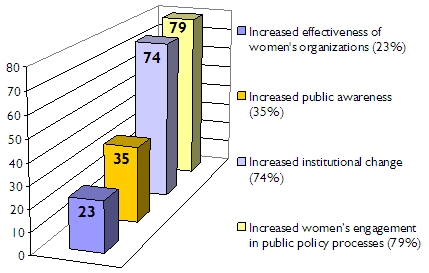
Projects completed in 2007–2008 addressed a number of issues: economic status of women (37 per cent), elimination of violence against women (24 per cent), and other issues (40 per cent). Also, they targeted different groups: women generally (57 per cent), immigrant and visible minority women (28 per cent), Aboriginal women (12 per cent), and senior women (19 per cent).
4 Most projects achieved more than one result.
Issues Addressed by Completed Projects
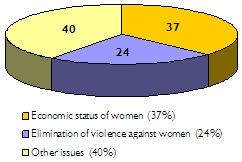
Groups Targeted by Completed Projects
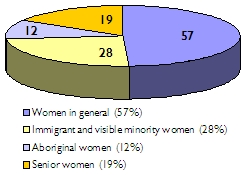
Examples of Completed Projects:
- The project titled Hul'qumi'num Women’s Caucus ($25,000), implemented by the Hul'qumi'num Women’s Treaty Group in British Columbia, facilitated the engagement of Aboriginal women in treaty and self-government processes by participating in discussions, identifying equality issues, and making recommendations. As a result, they increased awareness of their issues and provided input into the development of the Hul'qumi'num Agreement in Principle, constitution, and governance structures. Through this initiative, the women of Hul'qumi'num have increased their understanding of key governance and leadership issues and have been mobilized to engage in treaty and self-government processes.
- The Réseau des centres de femmes du Québec, an association of 102 women’s centres across Quebec, developed the project titled Le réseau des centres de femmes, engagé contre l’appauvrissement des femmes [the network of women’s centres, engaged against women’s poverty ($85,100)] to increase its participation and that of its members in fighting poverty and the exclusion of women. To achieve the desired results, the project’s first objective was to prepare a detailed portrait of the causes of poverty among women. To this end, some 250 copies of the document La pauvreté: une décision politique were published. The project’s second objective was to improve women’s centres’ strategies for local and province-wide action and mobilization. Through this project, the Réseau realized its full importance in partnering with various agencies and equipped its member centres with a wealth of documentation, including practical tools and plain language information on the status of women.
- The PLEIS-GIGNOO project in New Brunswick, The Healing Journey ($16,000), worked to increase public understanding of violence against Aboriginal women. A toolkit on violence against women was made available on and off reserve and among service providers, generating considerable positive response. The Department of Indian and Northern Affairs had requested that the group expand on the toolkit by adding materials from across Canada.
- The 411 Senior Centre Society received $127,750 for a project titled, Women Elders in Action (We* Act) of British Columbia. The project addressed economic security among senior women and looked at issues of pension reform. A position paper prepared by the group was used to increase awareness of and knowledge among senior women
with regard to issues of economic security and pension reform. Awareness raising activities included an ongoing radio program, “Kitchen Table Tours,” local grassroots meetings, and publishing articles and presenting at conferences. We* Act was invited to appear before the Standing Committee on the Status of Women and by the Standing Committee on Finance for a
pre-budget consultation.
Ongoing Projects (36): In 2007–2008, 36 projects were still in progress, of which 22 were approved under the old Terms and Conditions and 14 under the renewed funding requirements. The projects, all approved in previous fiscal years, were assessed on the progress made toward their completion and to determine the extent to which they will succeed in achieving expected results.
The analysis shows that more than 4,000 women will benefit from the 14 projects funded under the renewed funding requirements. The 22 projects approved under the old Terms and Conditions are expected to contribute to the SWC expected result—that is, knowledge and engagement toward gender equality through an increase in:
- the capacity of women’s organizations (14 per cent);
- public awareness on women’s issues (18 per cent);
- institutional change (27 per cent);
- the engagement of women in public policy processes (68 per cent).
Expected Results of Projects in Progress
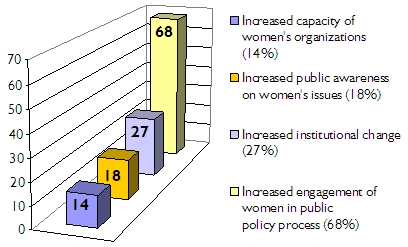
New Projects (181): In 2007–2008, a total of 181 new projects were funded under the current WP Terms and Conditions. Of these projects, 167 were supported through the WCF and 14 through the WPF. The extent to which these projects achieved their projected outcomes will be determined only upon their completion and following analysis of performance data.
By funding projects that have a direct impact on women, it is now possible to demonstrate how women benefit from the investments made and the results achieved by SWC, as highlighted below.
- Enhanced partnerships with federal institutions, other levels of government, NGOs and the private sector (8 per cent).
- Increased opportunities for women to participate in their communities (e.g. access to programs, services and others) (37 per cent).
- Direct benefits to women in terms of increased awareness of and knowledge in identifying and/or removing barriers to their participation in their communities (55 per cent).
Planned Results of Projects Approved During the Reporting Year5
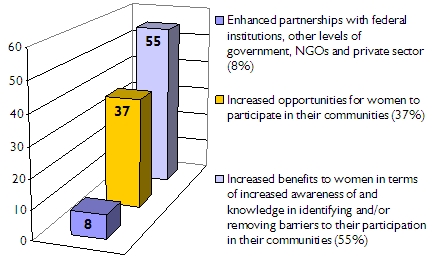
New projects targeted different groups6:
- Women in general (42 per cent)
- Aboriginal women (22 per cent)
- Immigrant and visible minority women (27 per cent)
- Senior women (9 per cent)
New projects addressed different issues7:
- Economic security/prosperity (42 per cent)
- Elimination of violence against women (33 per cent)
- Other issues (25 per cent)
5 Many of the projects are expected to achieve more than one result.
6 In many cases, projects address multiple issues and target multiple groups.
7 Some of the projects will address more than one issue.
Groups Targeted by New Projects
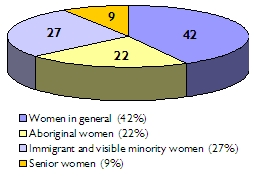
Issues Addressed by New Projects
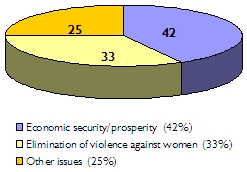
Examples of New Projects
WP Funding:
- Sunshine Coast Women’s Resources Society, Money Management for Women ($50,000): This project will address the need to increase the economic security of 200 women on the Sunshine Coast, British Columbia. The project will target seniors, First Nations, and visible minority women to ensure that those at risk will benefit from enhanced financial and economic literacy. Trained volunteer mentors will provide confidential individual support and advice on money management and in dealing with debt problems. The mentorship approach is accompanied by training to improve women’s knowledge, skills and confidence in managing their money.
- Hutton House Association for Adults with Disabilities, Life Coaching for Women with Disabilities ($140,888): This project will increase the capacity of women with disabilities to function independently, safely, and effectively within the London community. With information and tools, the women will gain self-confidence in addressing issues related to health/wellness, safety, daily activities, and community involvement.
- Canadian National Coalition of Experiential Women, BC’s Sex Workers and Sexually Exploited Youth: Escaping Violence, Addictions and Economic Despair ($195,569): This project will develop a specialized tool to assist government and community organizations in British Columbia to improve services to sex workers during their transition to recovery. Approximately 150 women will be assisted in exiting the sex trade and reintegrating in their respective communities, finding employment and resuming social life. The Comprehensive Resource Handbook to Support Sex Workers and Sexually Exploited Youth will be piloted in six communities in the province, where some of the women and girls most at-risk have been identified.
- Groupe Femmes, Politique et Démocratie, Centre de développement femmes et gouvernance ($1,050,000). Groupe Femmes, Politique et Democratie will work in collaboration with l’École nationale d’administration publique to provide leadership training, mentorship, and networking for 600 women in Quebec. The three components of the project will equip women with leadership skills and with experiences gained through mentorship and networking. It is expected that this project will result in increased participation by women in decision-making bodies in democratic institutions as well as the private and voluntary sectors. The Government of Quebec provided matching funds for this project.
Interdepartmental Funding:
The WP receives funding through two inter-departmental funding programs: the Interdepartmental Partnership with the Official Language Communities to support projects that address issues pertaining to official language minority women and the Family Violence Initiative to address issues of violence against women.
- The Fédération provinciale des fransaskoises received $236,400 for a project titled Ressources-mobiles pour développement économique au féminin to establish a team of French-speaking mobile resource persons in Saskatchewan trained in economic development and social services. This innovative project will establish a unit of resource persons to respond to community concerns and a toll-free telephone line that women can access to share their concerns (e.g., spousal abuse, special needs of immigrant women).
- In 2007–2008, the Native Women’s Association of Canada (NWAC) received $479,798 through the Family Violence Initiative (FVI) for a project to develop a Violence Prevention Toolkit. This project will train 200 youth and members of youth councils across Canada, who will subsequently become trainers, delivering workshops to increase
awareness. It will thus equip 1200 young Aboriginal women to deal with all forms of violence, including domestic violence, date violence, sexual assault, emotional abuse, and bullying. Different local organizations will collaborate through this project to develop violence prevention action plans to protect young Aboriginal girls and women.
Accountability
In 2007–2008, measures were taken to streamline the WP by introducing a more structured delivery model, a standard application and review process, and strategic investment focusing in key areas. These changes were important in meeting, among others, due diligence and accountability requirements. Moreover, SWC took measures to implement the commitments made in its Management Response to the 2005 summative evaluation of the WP and the 2006 Integrated Results-Based Management and Accountability Framework and Risk-Based Audit Framework (RMAF-RBAF).
The WP, with external expertise, conducted a review of its program delivery tools, such as Funding Guidelines, Call for Proposals documents, Application Guide and form, reporting and other templates. As a result, the WCF tools were streamlined, thus simplifying the application process for organizations. Tools were also improved to facilitate data collection, analysis, and reporting, and to strengthen overall accountability. In doing so, SWC addressed some of the issues identified by the summative evaluation, particularly with regard to the effectiveness of program delivery and performance measurement.
The WP also took steps to build staff capacity by delivering training on various program aspects. Introductory training was provided to officers in preparing “contribution agreements” and in performance measurement. A WP national meeting held in Moncton, New Brunswick, in 2007–2008 provided an opportunity for further training and discussions on issues related to program delivery, performance measurement, and others. A staff training/capacity-building plan will be implemented starting in 2008–2009.
As indicated in the Report on Plans and Priorities for 2007–2008, SWC is committed to developing a database that will be used to collect and analyze data and report on performance. The organization is exploring different options to identify a system that is cost effective and that meets its specific needs.
